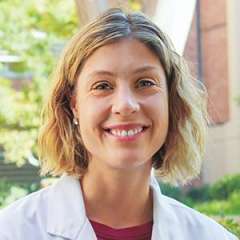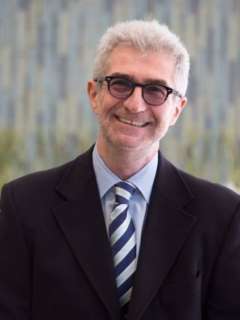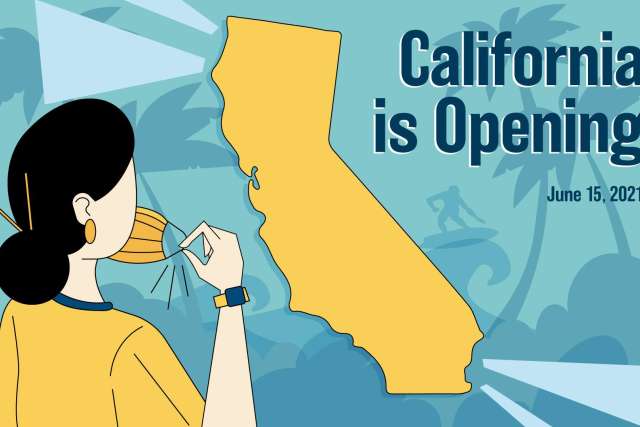Photo by Ann Johansson/UCLA Health
Note: This article was updated after the July 15 announcement that Los Angeles County would re-instate its indoor masking guidance.
California is set to fully reopen its economy on June 15, putting an end to business capacity restrictions, most mask mandates and social-distancing requirements.
Movie theaters can fill every seat, Dodger Stadium can once again welcome more than 50,000 fans per game and malls can swarm with shoppers. Visitors to Disneyland will no longer have to wear masks or physically distance outdoors or indoors, if they've been fully vaccinated.
But it will still take a while before things return to pre-pandemic normal.
When will masks be needed?
Masks will still be necessary in some circumstances for the foreseeable future. People who haven’t been vaccinated against COVID-19 must continue to wear masks in most settings, health officials say — but it’s on the honor system, meaning mask use won’t be enforced.
In recent weeks, the country has seen an uptick of COVID-19 cases. As of July 17, Los Angeles County is once again requiring that masks be worn indoors.
Masks are a must for all people, regardless of vaccination status, on public transport and transportation hubs, in K-12 schools and other childcare settings, in hospitals and long-term care facilities, in state and local correctional facilities and detention centers and homeless and emergency shelters.
Indoor “mega-events” with attendance of more than 5,000 people — such as concerts, conventions, festivals and sporting events — will require proof of vaccination or negative COVID-19 test. Such proof is also recommended for outdoor mega events.
Federal rules require masks to be worn on public transportation and in airports and bus and train depots.
As of June 17, workers who are fully vaccinated will no longer need to wear masks on the job. An individual is considered fully vaccinated two weeks after receiving the second dose of the Pfizer or Moderna vaccine or the single-dose Johnson & Johnson shot.
Masks are still required for patients and staff at UCLA Health.
Still, after 14 months of strict distancing, masking and minimizing crowds, the June 15 reopening represents the most significant move toward normal since the pandemic began. And California is well-positioned to make this transition safely, says Annabelle de St. Maurice, MD, MPH, co-chief infection prevention officer for UCLA Health.
How safe is it?
“There are two things that determine whether it’s safe to reopen,” says Dr. de St. Maurice. “One is vaccine rates — and our vaccine rates in California are pretty high. The other thing that affects reopening risk is prevalence of the disease, and our rates are really low.”
About 55% of Californians are fully vaccinated, with another 11% having received at least one dose of a two-dose vaccine. The state also has one of the lowest case rates in the country, with 1.7 new cases for every 100,000 residents as of June 8, according to state records.
The situation remains fluid, however, as summer travel brings people from other parts of the country into California and Californians travel out of state. About 42% of Americans are fully vaccinated.
Disease risk also varies by individual, Dr. de St. Maurice says.

People with obesity, asthma and heart disease who are at increased risk of serious illness from COVID-19, or people who are immunocompromised, might want to continue wearing a mask even if they’re fully vaccinated, she says. Children younger than 12 aren’t eligible for the vaccine, so it might be wise for them to wear masks in crowded settings, particularly if they have a chronic illness, Dr. de St. Maurice says.
Reconnecting with others
Even people who are healthy and fully vaccinated may feel trepidation about the state’s reopening. It’s not just about shedding masks, but shedding the protective cocoon we’ve been living in for more than a year.
We’re reacclimating to routines that include leaving the house and being around other people –and we’re doing so after a year of personal and collective losses that most of us are still processing.
Reconnecting socially under these circumstances can be daunting, says Emanuel Maidenberg, PhD, clinical professor of psychiatry at the David Geffen School of Medicine at UCLA. But it’s worth the effort, because social connection is essential to happiness and overall well-being.
“People may have gone through a year plus without much happening in their lives, so it’s hard to imagine what kinds of things to talk about when you meet people you used to regularly interact with,” he says. “But it’s important to make as much effort as possible to engage — and to realize everybody went through a similar challenge. The vast majority of people will be able to relate and feel some level of sympathy, empathy or understanding because they went through the same thing.”

Returning to a semblance of normalcy also means reassessing, and perhaps reducing, reliance on some the coping mechanisms adopted over the past year.
For example, many Americans upped their intake of food and alcohol during the pandemic, “something that may have been quite effective in the short run, but not likely to be helpful or sustainable in the long run,” Dr. Maidenberg says.
“One of the expected difficulties we are facing is having enough wisdom to separate the helpful from not helpful in the long run,” he says. “And the second question becomes: What is the most effective way to change back to a safer mode of being?”
Returning to society with care
Experts suggest reemerging gradually and monitoring personal comfort levels along the way.
Some people may wish to continue wearing masks, particularly if they have other illnesses or chronic conditions, Dr. de St. Maurice notes. Others may be slower to revisit crowded public places.
Still, it’s important to initiate contact with others and broaden beyond the pandemic seclusion and coping mechanisms, Dr. Maidenberg says. “Adopt an attitude of curiosity, rather than cautious apprehension — which is something that will naturally be part of this process,” he says.
It’s also important to respect others as we navigate this path to normal.
“I’m excited that we’re in this place where we’re even talking about it,” Dr. de St. Maurice says. “I think it will be good for our mental health to have more opportunities to get together. I just hope that we continue to see these low rates. And I hope it encourages more people to get vaccinated, because as we’re opening up, the single best way to protect yourself is to get vaccinated.”
For more COVID-19 information and FAQs, visit the COVID-19 Vaccine Information Hub.
Related articles
No more masks on the job for California workers fully vaccinated for COVID-19
If shedding your face mask makes you anxious, you're not alone
Children 12 and older can now get the COVID-19 vaccine - and here's why they should
COVID-19: Track the latest developments and look back at how the pandemic began





